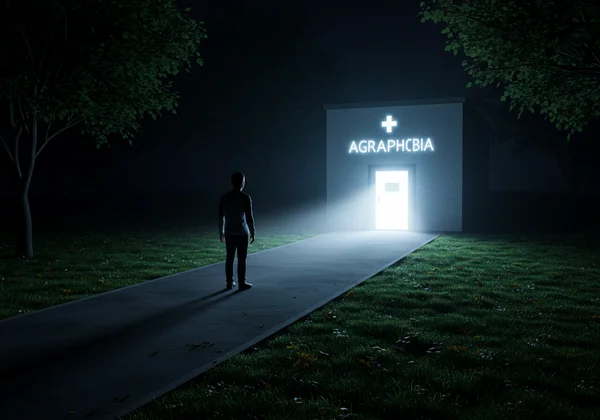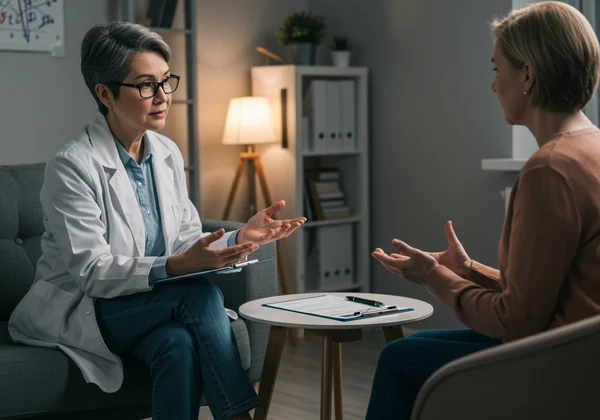Agoraphobia Diagnosis: Your Guide to a Professional Agoraphobia Test & Assessment
Facing uncertainty about agoraphobia is overwhelming. Perhaps you've taken a preliminary step, like an online agoraphobia test, and now you’re wondering what comes next. Understanding the professional diagnosis process is a powerful move toward empowerment. This guide will demystify what to expect when seeking help from a mental health expert, explaining how they test for agoraphobia in a clinical setting. Taking a confidential agoraphobia self-assessment is an excellent starting point for this journey.

Understanding Agoraphobia Diagnosis Criteria
A professional diagnosis isn't a simple checklist; it's a comprehensive evaluation by a qualified mental health professional, such as a psychologist or psychiatrist. They use the Diagnostic and Statistical Manual of Mental Disorders (DSM-5) to ensure an accurate assessment and to differentiate agoraphobia from other conditions.
What Symptoms Professionals Look For (Based on DSM-5)
For an agoraphobia diagnosis, a clinician looks for a marked fear or anxiety about two or more of the following situations:
- Using public transportation (buses, trains, planes).
- Being in open spaces (parking lots, marketplaces, bridges).
- Being in enclosed places (shops, theaters, cinemas).
- Standing in line or being in a crowd.
- Being outside of the home alone.
The core fear is the thought that escape might be difficult or help unavailable if panic-like symptoms occur. The professional will also assess if you actively avoid these situations or endure them with intense anxiety. This pattern of agoraphobia symptoms must typically persist for six months or more and cause significant distress or impairment in your daily life.

Distinguishing Agoraphobia from Other Anxiety Disorders
A key part of the diagnostic process is ruling out other anxiety disorders. For instance, Social Anxiety Disorder involves fear of social scrutiny, whereas agoraphobia is about the fear of being trapped. Panic Disorder can co-occur with agoraphobia, but they are distinct conditions. A professional will carefully explore your specific triggers to arrive at the correct conclusion, which is critical for effective treatment.
Beyond an Online Agoraphobia Test: The Professional Assessment Process
Knowing what to expect during a formal evaluation can significantly ease any anxiety about the process itself. The assessment is a collaborative effort designed to understand your unique challenges in a safe and supportive space.
Your Initial Consultation: Sharing Your Experiences
The first appointment is mainly a conversation. Your doctor or therapist will ask you to describe what you've been going through—your fears, the situations you avoid, and how these feelings impact your life. This is your opportunity for sharing your experiences openly and honestly. The focus is entirely on understanding you.
Questionnaires and Psychological Evaluations
To supplement the conversation, your clinician may use standardized questionnaires or rating scales. These formal psychological evaluations are more in-depth than an initial online agoraphobia test and provide objective data to help quantify the severity of your symptoms. They also establish a baseline for tracking your progress once treatment begins.

Ruling Out Other Conditions: Physical Health Checks
Because some medical conditions can mimic anxiety symptoms, a professional will often recommend a physical check-up. Issues like thyroid problems or heart conditions can cause dizziness or a racing heart. Conducting physical health checks ensures your diagnosis is accurate and that any underlying medical issues are addressed. If you want to understand your condition better beforehand, an online quiz can be a useful tool.
Preparing for Your Professional Agoraphobia Test & Diagnosis
Taking an active role in your diagnostic appointment can empower you and ensure you get the most out of the consultation. A little preparation goes a long way in making you feel more in control.
Key Information to Share
Before your appointment, jot down some notes to ensure you don’t forget anything important. Consider documenting:
- A list of your specific symptoms and fears.
- Which situations you avoid and why.
- When your symptoms started and how often they occur.
- Any past experiences with panic attacks.
- How your symptoms affect your daily routine.
- Other mental or physical health conditions you have.
- A list of any medications or supplements you are taking.
Questions to Ask Your Mental Health Professional
Your appointment is a two-way street. Preparing a list of questions to ask helps you feel more informed and involved. You might ask:
- Based on what I’ve shared, what is your initial assessment?
- What are the potential treatment options for me?
- What does the treatment process typically involve?
- Can you recommend any support groups or resources?
Bringing a Support Person (If You Wish)
You don't have to go through this alone. Bringing a trusted friend or family member can be incredibly helpful. A support person can offer comfort, help you remember details, and provide additional insight. Their presence can make the experience feel much less intimidating. Now might be the time to start your journey.
After Receiving an Agoraphobia Diagnosis
Receiving a formal diagnosis can bring a mix of relief and concern. This diagnosis is not a label that defines you; it is a key that unlocks the door to effective treatment and recovery.
Understanding Your Diagnosis and Treatment Options
Once a diagnosis is confirmed, your mental health professional will discuss a personalized treatment plan with you. The most effective treatment options for agoraphobia often include therapy, particularly Cognitive-Behavioral Therapy (CBT) with exposure therapy. In some cases, medication may be recommended to help manage severe anxiety or panic symptoms.
Why a Formal Diagnosis Matters for Your Journey
A formal diagnosis matters because it validates your struggles and provides a clear direction for treatment. It confirms the initial insights you may have gathered from an agoraphobia self-assessment and allows professionals to tailor strategies specifically to your needs. This clarity is the first major step toward managing your symptoms and reclaiming your life. For a preliminary look at your symptoms, you can always take the free quiz.

Taking the first step towards understanding your agoraphobia, whether through a quick online agoraphobia test or a professional diagnosis, is a powerful act of self-care. It's a vital part of your journey toward managing your symptoms and reclaiming your sense of freedom. While a preliminary agoraphobia screening test can provide valuable insights, a formal assessment opens the door to personalized, evidence-based treatment strategies. By knowing what to expect, you can approach this process with confidence. Remember, seeking help is a profound sign of strength, and with the right support, you can learn to navigate the world with greater ease. Ready to explore your feelings? You can try our free tool today.
Frequently Asked Questions About Agoraphobia Diagnosis
How do professionals formally diagnose agoraphobia?
Professionals use a clinical interview to discuss your symptoms, fears, and avoidance behaviors. They compare this information against the DSM-5 criteria, may use standardized questionnaires, and will rule out other medical or psychiatric conditions to ensure an accurate diagnosis. This is far more comprehensive than an initial self-assessment.
What are the different severity levels of agoraphobia?
Agoraphobia exists on a spectrum. Mild cases may involve avoiding a few specific situations while maintaining most daily activities. In severe cases, a person may become almost completely housebound. A professional assessment determines this severity to guide the appropriate treatment.
What other conditions can agoraphobia be mistaken for?
It can be mistaken for Social Anxiety Disorder, Panic Disorder, or Specific Phobias like claustrophobia. A thorough diagnostic process is essential to distinguish between these conditions, as the focus of treatment can differ significantly.
Can you have agoraphobia and still leave the house?
Yes, absolutely. Many people with agoraphobia are not completely housebound. They may be able to leave home with a trusted companion, for short distances, or to a few "safe" locations, often enduring these situations with extreme distress. A free agoraphobia test can help you explore these nuances.
Is it possible to suddenly develop agoraphobia?
While it often develops gradually, agoraphobia can sometimes appear more suddenly, especially after a series of unexpected panic attacks. A person might have a panic attack in a public place and then quickly develop a fear and avoidance of similar situations.